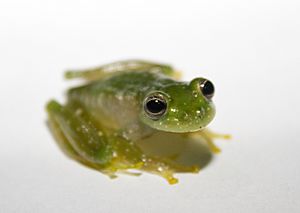Powdered glass frog facts for kids
Quick facts for kids Powdered glass frog |
|
|---|---|
 |
|
| Conservation status | |
| Scientific classification | |
| Synonyms | |
|
Many, see text |
The powdered glass frog or Chiriqui glass frog (Teratohyla pulverata) is a type of frog. It belongs to the glass frog family, called Centrolenidae. You can find this frog from central Honduras all the way south to northwestern Ecuador.
What They Look Like
The powdered glass frog is a small frog. Adult males are about 22–24.5 millimeters long from their snout to their rear. Females are a bit bigger, measuring 25.3–28.3 millimeters. Their snout looks rounded when you see it from above. From the side, it has a distinct slope.
These frogs are green on top. They have many tiny white spots scattered across their back. This is why they are called "powdered." Their back feels a bit rough, especially in males. It has tiny bumps called spicules.
Their belly is clear, or transparent. This means you can see through it! You can often see their green bones and some internal organs. This is because the outer layer covering their organs is also completely clear. The inner layers around their liver and stomach are white.
Their eyes have a greyish-white iris. It has small yellow dots and thin, dark-grey lines. A thin cream-yellow ring goes around their pupil. The tips of their fingers and toes have small discs. These discs help them grip surfaces.
Where They Live and How They Live
The powdered glass frog lives in warm, wet lowland forests. They are often found near rivers and streams. In the northern parts of their home range, they live on the Atlantic side of the mountains. On the Pacific side, they are found from Costa Rica southwards. They can live up to 960 meters (about 3,150 feet) above sea level.
Male frogs call from the top sides of leaves. Their call has three short notes, each lasting about 0.05 seconds. They pause for about half a second between notes.
Female frogs lay their eggs on the top sides of leaves. They usually choose leaves that hang over small streams. When the eggs hatch, the tiny tadpoles drop into the water below. The parent frogs do not stay to guard the eggs or care for their young.
This frog is fairly common in Honduras. It is less common in Costa Rica and rarely seen in Colombia. Even though some forests are getting smaller, this frog can still survive in small patches of forest. Because of this, scientists do not consider it to be in danger.
Their Name History
Like many glass frogs, the powdered glass frog has had a confusing history with its name. Scientists often change how they classify animals as they learn more.
This frog was first thought to be a type of tree frog. Later, scientists realized it was a glass frog. It was then placed in different groups over the years. In 2008, scientists found that another frog, called Cochranella petersi, was actually the same species. In 2009, it was finally moved to its current group, Teratohyla.
So, this frog has had many different scientific names over time. This shows how scientists keep learning and updating their knowledge about the natural world!
See also
 In Spanish: Teratohyla pulverata para niños
In Spanish: Teratohyla pulverata para niños


